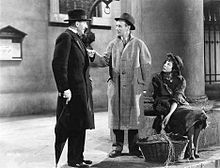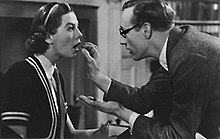Pygmalion (1938 film)
| Pygmalion | |
|---|---|
 Poster | |
| Directed by | Anthony Asquith Leslie Howard |
| Screenplay by | George Bernard Shaw W.P. Lipscomb Cecil Lewis Ian Dalrymple |
| Based on | Pygmalion by George Bernard Shaw |
| Produced by | Gabriel Pascal |
| Starring | Leslie Howard Wendy Hiller Wilfrid Lawson Leueen MacGrath |
| Cinematography | Harry Stradling |
| Edited by | David Lean |
| Music by | Arthur Honegger |
| Distributed by | General Film Distributors (GFD) (UK) Metro-Goldwyn-Mayer (US) |
Release date |
|
Running time | 96 minutes |
| Country | United Kingdom |
| Language | English |
| Budget | £87,000[1] |
| Box office | $1.4 million[2] |
Pygmalion is a 1938 British film based on the 1913 George Bernard Shaw play of the same name, and adapted by him for the screen. It stars Leslie Howard as Professor Henry Higgins and Wendy Hiller as Eliza Doolittle.
The film was a financial and critical success, and won an Oscar for Best Screenplay and three more nominations; Best Picture, Best Actor (Howard) and Best Actress (Hiller). The screenplay later was adapted into the 1956 theatrical musical My Fair Lady, which in turn led to the 1964 film of the same name.
Adaptation[]

The Hungarian producer Gabriel Pascal wished to create a set of films based on Shaw's works, beginning with Pygmalion, and went to see Shaw in person to gain permission to do so. Shaw was reluctant to allow a film adaptation of Pygmalion owing to the low quality of previous film adaptations of his works, but Pascal managed to convince him (on the condition Shaw retained constant personal supervision of the adaptation)[3] and later went on to adapt Major Barbara, Caesar and Cleopatra and Androcles and the Lion.
The resulting Pygmalion scenario by Cecil Lewis and W.P. Lipscomb removed exposition unnecessary outside a theatrical context and added new scenes and dialogue by Shaw. Ian Dalrymple, Anatole de Grunwald and Kay Walsh also made uncredited contributions to the screenplay. A long ballroom sequence was added, introducing an entirely new character, Count Aristid Karpathy (seen both here and in the musical My Fair Lady, named as Professor Zoltan Karpathy – mentioned in the final scene of the original play, but with no name or onstage appearance), written wholly by Shaw. Against Shaw's wishes, a happy ending was added, with Eliza fleeing Higgins with Freddy but then returning to Higgins's home (though whether permanently or on her own terms is left deliberately ambiguous). Shaw and his fellow writers did, however, retain the controversial line "Not bloody likely!" from the play's text, making Hiller possibly the first person to utter that swear word in a British film[3] and giving rise to adverts for the film reading "Miss Pygmalion? Not ****** likely!".[citation needed]
Plot[]
While wandering around Covent Garden transcribing bits of conversation from passers-by, the linguist Professor Higgins is mistaken for a policeman, causing protests from the flower girl Eliza Doolittle. The incident is also clarified with the help of Colonel Pickering, also a scholar of languages and dialects, who came from India precisely to meet Higgins. Bragging about Pickering, Higgins argues that by teaching her to speak correctly, Eliza could have a better fate; indeed, he would be able to pass her off as a duchess. The girl then shows up at Higgins' house to take pronunciation lessons. Colonel Pickering then makes a bet with Higgins: he offers to pay all the expenses if the professor manages to make the girl pass for an elegant lady in the space of a few weeks.
A first disappointing experiment takes place in the house of Higgins' mother, at a tea, during which the girl scandalizes those present with her speeches even if pronounced with perfect accent. But one of the guests - young Freddy - is fascinated by Eliza.
After a tiring internship to which she is subjected by an inflexible Higgins, and during which the young Freddy tries in vain to see her again, Eliza is finally led by Higgins and Pickering to an embassy reception. Here Higgins meets his former pupil, Count Aristid Karpathy, who has become famous and in demand for his ability to recognize the origin of high society people from their way of speaking. Higgins and Pickering fear that Eliza will cheat on him, but she manages to deceive him perfectly and is so successful that she is mistaken for a princess.
Returning from the reception, Higgins and Pickering congratulate each other on their success, neglecting the important contribution of Eliza and her commitment. Wounded by the indifference of Higgins, with whom she fell in love, the girl escapes by taking refuge in the home of the professor's mother. Here the teacher and student have a further discussion at the end of which Eliza abandons Higgins and leaves with the young Freddy, threatening to offer herself as assistant to Aristid Karpathy.
Back home alone, Professor Higgins destroys some records in a fit of rage and listens to one of the first recordings of Eliza's voice. This is revealed a few moments later in the professor's room, and the film ends (unlike the previous play) with an open and rather hopeful ending.
Cast and crew[]
Wendy Hiller was chosen by Shaw to play Eliza Doolittle after she had appeared in stage productions of Pygmalion and Saint Joan – though the film's initial credits stated that this movie was introducing her, she had in fact already appeared on film in 1937's Lancashire Luck. Shaw's choice for Higgins had been Charles Laughton. The movie also includes the very first film appearance (brief and uncredited) of Anthony Quayle, as an Italian wigmaker. Cathleen Nesbitt, credited here as Kathleen Nesbitt in the role of 'A Lady,' portrayed Mrs. Higgins in the original Broadway production of My Fair Lady 18 years later.
The film's crew included David Lean (on his first major editing job; he also directed the montage sequence of Higgins teaching Eliza), set designer Laurence Irving and the camera operator Jack Hildyard (who later did the photography for Lean's The Bridge on the River Kwai, The Sound Barrier and Hobson's Choice).
Cast[]

- Leslie Howard as Professor Henry Higgins
- Wendy Hiller as Eliza Doolittle
- Wilfrid Lawson as Alfred Doolittle
- Marie Lohr as Mrs. Higgins
- Scott Sunderland as Colonel George Pickering
- Jean Cadell as Mrs. Pearce
- David Tree as Freddy Eynsford-Hill
- Everley Gregg as Mrs. Eynsford-Hill
- Leueen MacGrath as Clara Eynsford-Hill
- Esme Percy as Count Aristid Karpathy
- Violet Vanbrugh as the Ambassadress
- Iris Hoey as Ysabel, Social Reporter
- Viola Tree as Perfide, Social Reporter
- Irene Browne as the Duchess
- Kate Cutler as The Grand Old Lady
- Cathleen Nesbitt as Old Lady
- O. B. Clarence as Mr. Birchwood, the Vicar
- Wally Patch as First Bystander
- H. F. Maltby as Second Bystander
- Ivor Barnard as Sarcastic Bystander
- Cecil Trouncer as First Policeman
- Stephen Murray as Second Policeman
- Eileen Beldon as Mrs Higgins’s Parlourmaid
- Frank Atkinson as Taxi Driver
Uncredited
- Leo Genn as a Prince
- Moyna Macgill as a Woman Bystander
- Patrick Macnee as an Extra
- Anthony Quayle as Eliza's Hairdresser
Reception[]
George Bernard Shaw, Cecil Lewis, Ian Dalrymple, and W.P. Lipscomb[4] won the 1938 Academy Award for Writing (Adapted Screenplay). The film also received nominations for Best Picture, Best Actor (Howard) and Best Actress (Hiller). Shaw's reaction to his award was: "It's an insult for them to offer me any honour, as if they had never heard of me before – and it's very likely they never have. They might as well send some honour to George for being King of England [sic]." However, his friend Mary Pickford later reported seeing the award on display in his home.
At the 1938 Venice Film Festival, Leslie Howard won the Volpi Cup and the film was nominated for the Mussolini Cup.
The copyright of the film Pygmalion lapsed in the United States in 1966 after its rights holder, Loew's Incorporated, failed to renew its copyright registration; as such, the film entered the public domain. However, in the 9th Circuit case Russell v. Price (1979), Shaw's estate was able to assert its rights in the underlying work (Shaw's play), and thus retain control over the film's distribution and public performance in the United States as a derivative work.[5] US copyright in Shaw's play ended in 1988, which also restored the film to public-domain status.
Bibliography[]
- The Great British Films, pp. 45–48, Jerry Vermilye, 1978, Citadel Press, ISBN 0-8065-0661-X
References[]
- ^ "Hollywood Merry Go Round". The Barrier Miner. Broken Hill, NSW: National Library of Australia. 29 June 1939. p. 5 Edition: Home Edn. Retrieved 5 August 2012.
- ^ Balio, Tino (2009). United Artists: The Company Built by the Stars. University of Wisconsin Press. ISBN 978-0-299-23004-3. p220
- ^ Jump up to: a b W.G.M. (24 March 1939). "Shaw on the Screen". The West Australian. 55 (16, 452). Western Australia. p. 3. Retrieved 20 February 2018 – via National Library of Australia.
- ^ Associated Press. Cecil Lewis, 98, Pilot In Wartime, Writer And Oscar Winner. New York Times, 2 February 1997. Retrieved 20 February 2018
- ^ Steven Mitchell Schiffman, “Movies in the Public Domain: A Threatened Species”. Columbia-VLA Journal of Law and the Arts 20 (1996), pp. 663-681, at p. 670.
External links[]
- Pygmalion is available for free download at the Internet Archive
- Pygmalion at IMDb
- Pygmalion at AllMovie
- Pygmalion at the TCM Movie Database
- Pygmalion at Rotten Tomatoes
- Pygmalion at the BFI's Screenonline
- 1938 films
- English-language films
- 1930s romantic comedy-drama films
- British black-and-white films
- British films
- British films based on plays
- Films based on works by George Bernard Shaw
- Films directed by Anthony Asquith
- Films directed by Leslie Howard
- Films produced by Gabriel Pascal
- Films set in London
- Films whose writer won the Best Adapted Screenplay Academy Award
- Films shot at Pinewood Studios
- Films with screenplays by Anatole de Grunwald
- Films with screenplays by Ian Dalrymple
- British romantic comedy-drama films
- 1938 comedy films
- 1938 drama films
